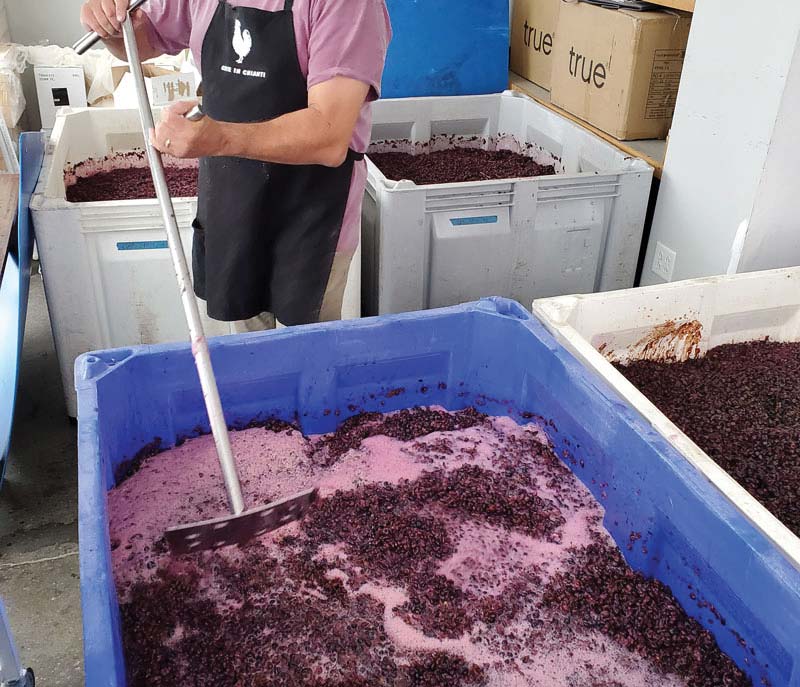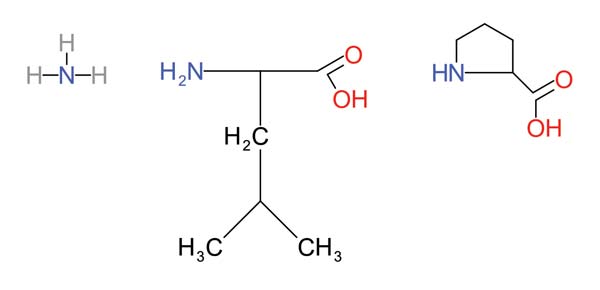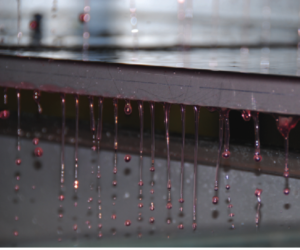
Nitrogen is one of the most vital components for a successful primary fermentation. Along with several co-factors, it can dramatically impact the complexity and organoleptic character of a wine. Deficient nitrogen is one of the main causes of sluggish and stuck fermentations. This article will cover a primer on why nitrogen is important to a fermentation, the timing of additions, and some possible outcomes of nitrogen supplementation.
Nitrogen is naturally found in grape juice in two forms: Ammonia (NH3) and amino nitrogen (nitrogen attached to amino acids). Yeast can metabolize all 20 naturally occurring alpha amino acids but struggles with proline due to its unique five-body pyrrolidine ring that binds the nitrogen group. As a rough average, the nitrogen in grape juice contains about one-third ammonia and two-thirds amino acids. Yeast assimilable nitrogen (YAN) is a measure of the nitrogen available to yeast to use in fermentation. It is the combination of the available nitrogen contributed from free alpha amino acids (excluding proline), free ammonia, ammonium (ionized ammonia), and small peptides found in the grape juice.

Wine yeast has a natural preference for ammonia. “Gate proteins” in the cell wall will prevent amino acids from entering the cell in the presence of ammonia. Therefore, the natural ammonia contribution of YAN from the juice will usually be consumed during the logarithmic growth stage of the yeast. During this phase of growth, the yeast will rapidly reproduce and consume very little sugar. Once the population stabilizes, yeast will begin to break down sugars and produce alcohol. This is called the stationary phase (a reference to the stable population size).
At this point nitrogen is consumed to help synthesize proteins and vital factors for yeast health. Winemakers can use the behavior of yeast to help influence aromatic profiles of the final wine. When yeast consume the nitrogen sourced from amino acids, the remainder of the molecule may be used to create interesting aromatic compounds like esters and thiols if the correct conditions exist. The active yeast needs to be able to produce the correct enzymes for this type of syntheses, so the levels of thiol and ester production can be very yeast strain specific. Each unique strain has varied capabilities to produce these compounds, so yeast selection is essential.
Testing For YAN
Levels of nitrogen compounds that develop in grapes are influenced by weather, cultivation practices, vineyard sprays, irrigation, and factors from the natural environment like predation from birds and the spotted lanternfly. Testing of the YAN is vital to the success of a fermentation. Some fruit suppliers will provide chemical grape analysis for purchased fruit. Often, they will be able to provide pH, TA (titratable acidity), and other info as well. It is important that lab information is obtained from fruit sampled within three days of harvest. Variance of more than three days can have a big impact on all the vital information.
Testing for YAN can be completed by wet chemistry, enzymatic analysis, and HPLC (high-performance liquid chromatography). There are many commercial labs that can provide a juice analysis that will include at a minimum YAN, pH, and TA. Testing can also be provided by any university with a wine program. These lab tests should be available for under $100 and are well worth the money. It is common to observe variations in the YAN every year with fruit sourced from the same vineyard and under similar conditions. This is something that should be tested every year and for every lot. Note: The wet chemistry methods for measuring YAN involve the use and subsequent disposal of formaldehyde. It is much safer and more reliable to have a wine lab or trained professional perform this analysis. Home testing is not recommended.
Once you have the starting Brix and YAN, the state of nutrition of the must can be assessed. Under normal fermentation conditions with sugars from 22 to 24 °Brix, must with a YAN under 100 ppm is considered deficient and should be supplemented to complete a healthy fermentation. Must in the range of 150 to 250 ppm YAN is at moderate risk, and supplementation should be considered to enhance the quality of the final product. Must with YAN over 250 ppm may need to be supplemented to accommodate a higher biomass from the yeast. In this case, the natural balance of resources and factors needed for growth like magnesium, zinc, and thiamin can become rapidly depleted due to the higher cell counts of yeast.
High nitrogen fermentations tend to become stressed and produce sulfides toward the end of fermentation. Musts with sugar levels over 24 °Brix generally need some nutrient additions to maintain the health of the yeast and complete fermentation. The higher level of alcohol that comes along with high sugar can often require nutrients that include yeast hulls, sterols, and vitamins, which will help support the yeast in these stressful conditions.
Timing Is Everything
The timing of nitrogen additions is almost as critical as the addition itself. At one time, it was believed that the nitrogen could be supplemented with one addition of DAP (diammonium phosphate) at the onset of fermentation. This often created a huge cell population of yeast and would cause a stressed fermentation.
When yeast consume the nitrogen sourced from amino acids, the remainder of the molecule may be used to create interesting aromatic compounds like esters and thiols if the correct conditions exist.
The development of more complex nutrients for yeast also led to a greater understanding of how the nutrients are used by yeast. In the growth stage of fermentation, a large portion of the nutrients are consumed in the process of yeast reproduction. Amino acids are critical to this stage of growth to build healthy and robust cells. If the only available source of nitrogen is ammonia, the yeast may become stressed and start producing reductive aromas like hydrogen sulfide.
Many manufacturers of yeast nutrients recommend breaking the addition into two or more feedings often using a combination of organically derived nitrogen and DAP. Dividing the feeding of the fermentation into stages provides an additional level of control. More nitrogen can be added if the fermentation is too slow, less can be added if the fermentation is too fast or hot. When this action is chosen, the feeding can be divided into further parts (if needed) to make sure the entire required amount of nitrogen is added.
For the purpose of supplementation, fermentations are divided into the following stages:
Inoculation — The time when the yeast that will be conducting the actual fermentation is added to the must. If using a non-Saccharomyces yeast as a pre-fermentation treatment, it is important to wait for the addition of the fermentation yeast before any nutrient supplementation. Feeding before an active yeast strain is added may cause unwanted bacteria and spoilage yeast to grow. In a natural (uninoculated) fermentation, inoculation should be considered the point at which fermentation is observable, but there has been no real drop of Brix.
End of Growth Stage — This stage is marked by a decrease of Brix by two to four degrees. By this point, the yeast has reached its full population density, and reproduction has slowed to maintain a steady cell count. Active fermentation in the form of bubbling or cap formation should be present. A large portion of the nitrogen will have been consumed by this point. At this stage of growth, nitrogen is primarily used for protein synthesis and helps maintain vital cell functions.
Mid Fermentation — When the must reaches about 10 to 12 °Brix, the fermentation has different needs. This is one of the most critical feedings as it will be the last opportunity for yeast to take on nitrogen vital to finishing a healthy fermentation. At this stage, a blend of DAP and amino acids is especially useful. The DAP will keep the ferment moving and the amino acids will provide essential building blocks to help finish clean and strong. Alcohol becomes a factor at this stage of the fermentation and the nutrients at this stage will help fortify the yeast against toxicity. After this point the alcohol level in the must will begin to interfere with nutrient intake. Nitrogen left in wine after fermentation is complete can dull the perception of fruit, may become food for unwanted microbes, and has the potential to bind with ethanol to develop unwanted compounds.
End of Fermentation — Though not a nitrogen addition, it is often recommended to add yeast hulls at the end of fermentation when the must drops to 5 °Brix or below. Because the phospholipid bilayer that makes up the hull or husks of the yeast is incredibly absorptive, this addition helps to remove toxins from the must and create a better environment for yeast to finish fermentation. It is important to use yeast hulls that are grown specifically for this purpose. This should add no nitrogen to the fermentation.
There are several other times to consider supplementation of your must. Products like Startup and Go-Ferm can be added to the rehydration water for yeast. These add peptides, vitamins, minerals, and sterols, which potentially help build strong yeast. They also can help develop more stable color and aromas.
Forms of Nitrogen Additions
Inactivated and autolyzed specialized yeasts are relatively new innovations that can be added to fermentations. These inactive yeasts are grown to possess a specific trait that can be utilized to enhance wine including added enzymes, glutathione for protection against oxidation, polysaccharides that can increase mouthfeel, compounds that reduce green and underripe characteristics, precursors for thiol and ester creation, and other qualities. There are many of these additives and they are widely available from the producers and distributors of yeast nutrients.
Unless they are specifically formulated to act as a nutrient, most of these additives do not add a significant amount of nitrogen to a fermentation and can be used without altering a nutrient supplication program. To achieve the desired goal of the additive, timing of the addition is critical. The choice of yeast will also impact the effectiveness of many of these additions. This is especially true for characteristics like ester and thiol creation, which largely happen during the processes of fermentation.
Nutrients are commercially available as single ingredients like autolyzed yeast, DAP, yeast extract, minerals, vitamins, and yeast hulls. These component ingredients will need to be combined with at least one or more other fundamental ingredient to create the nutrition needed for a balanced fermentation.
Base ingredients offer the advantage of fine-tuning the supplementation of a fermentation. Many suppliers have created proprietary nutrient blends. Because these complex blends differ from manufacturer to manufacturer, it is important to read the technical sheets prepared for each product. It is possible to supplement with products from different suppliers, but it is important to make sure you are not over or under feeding in your total additions. This is especially true with factors like thiamin, which is high in some complex blends and low or absent in others.
The nitrogen content and addition recommendations should be included on all the technical sheets. Many will also include information as to the timing of addition for the best results. Several of the complex nutrient blends will include recommended dosages based on the YAN content of the must and total required nitrogen addition.
Often a small addition of DAP (0.06 g/L) will help stop a fermentation from creating reductive aromas by “jump starting” the sulfur reductase pathway. In stressed conditions, yeast will stop using this process and excess hydrogen sulfide will be released into the must. This technique can only be used if the must has not dropped more than 12 °Brix or the nitrogen may not be utilized.
The Australian Wine Research Institute has shown that an increase of as little as 50 ppm nitrogen can greatly increase the aromatics of a wine when compared to an unsupplemented sample of the same juice. Whether using a complex nutrient or creating a custom nutrient blend, most fermentations and wines will benefit from balanced nitrogen additions.
To learn more about the theory and practice of these topics, here is a list of webpages that I recommend for my fellow winemakers:
https://waterhouse.ucdavis.edu/whats-in-wine
https://psuwineandgrapes.wordpress.com/2020/07/28/why-when-and-how-to-measure-yan/
https://www.awri.com.au/industry_support/winemaking_resources/wine_fermentation/yan/#:~:text=
Nitrogen%20is%20a%20critical%20grape,sulfur%20compounds%20and%20’reduction’.
https://www.lallemandwine.com/wp-content/uploads/2015/07/WE8-The-many-roles-of-nitrogen-in-alcoholic-fermentation.pdf
https://www.frontiersin.org/articles/10.3389/fmicb.2017.02554/full
https://www.ncbi.nlm.nih.gov/pmc/articles/PMC6524682/
Finally, at the end of this paragraph is a list of vendors that sell many of the products mentioned above. This list is not a recommendation or endorsement but is only provided as resources to explore. Incidentally, they are also great sources of information. They all have online shops where these products can be purchased: Scott Labs, BSG Wine, Laffort, Enartis, and Lamothe-Abiet.







